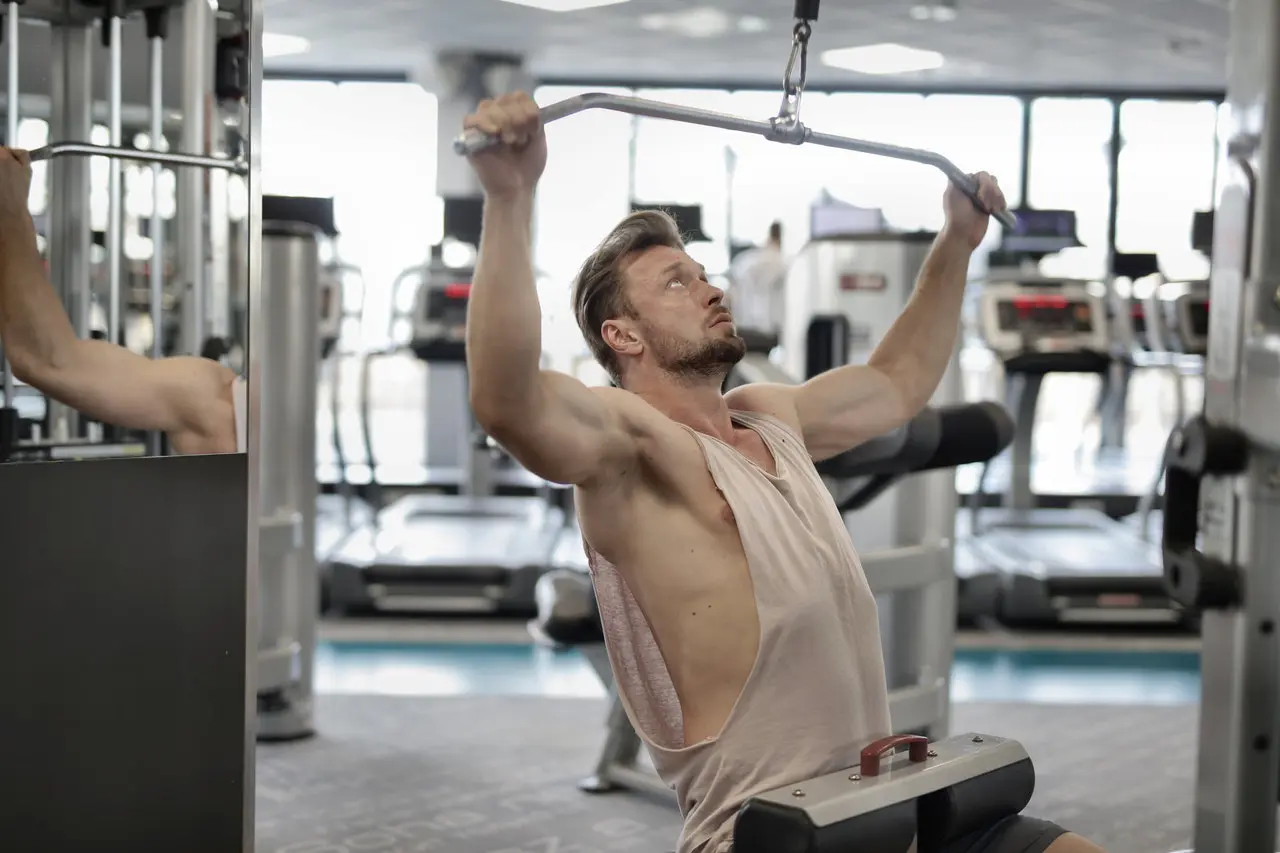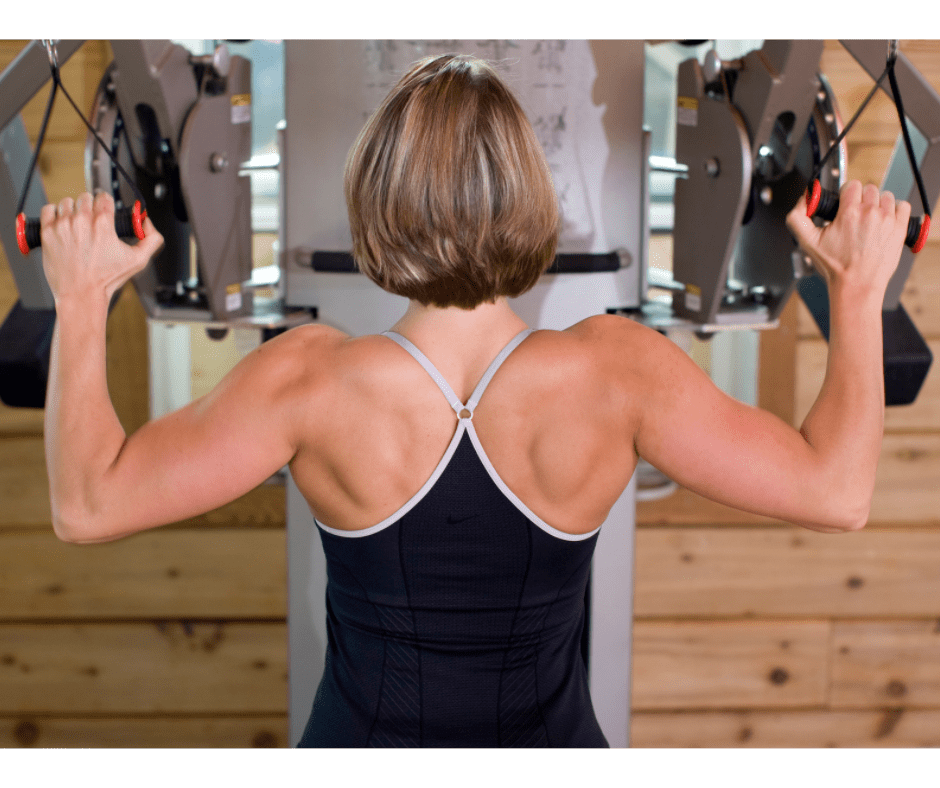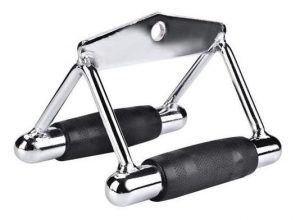
The best online fitness resource you'll ever need. We filter out the BS to ensure you meet your health and fitness goals!

The best online fitness resource you'll ever need. We filter out the BS to ensure you meet your health and fitness goals!

There is an abundance of vertical pulling exercises designed to develop the lats and surrounding muscles that enhance that coveted “V” shaped back.
To make your back look like the letter V, you need to increase your shoulder-to-hip ratio. To the guys out there, studies have shown that a large shoulder-to-hip ratio increases sex appeal, *wink* *wink*.
We’ve talked before about how wider shoulders and a narrower waist make men sexier. It’s been documented in the clinical psychology literature. So how to work on that “V” created by wide shoulders and back tapering down to a narrow waist?
Question is, which vertical pulling exercises do we need to do? Or do we have to do them all?
Some are better than others when analyzed while considering two key factors:
We’ve researched, experimented, and refined the list of the best vertical pulling exercises that will grow your back fastest, when viewed from the front…and from the side.
We’ll break the list down into the best isolation and compound vertical pulling exercises for lats and for traps.
Isolation Vertical Pulling Exercise for the Lats
The back was always my favorite body part, and the amount of work I put into it reflected that favoritism. Back work for days. Loved it then and still do.
During my powerlifting days, I built a respectable back by doing every deadlift variation in captivity, plus rows, pulldowns, high pulls…you name it.
And then a friend introduced me to the lat pull-in. All I can say is “wow”, and “damn”. “Wow”, that I can’t believe the results even at my age, and “damn”, that I didn’t learn about this incredible exercise sooner.
The Lat Pull-in makes up 95% of my lat work because frankly, I don’t find the need to do anything else for lats.

Using an adjustable height cable-pulley machine, sit where the pulley is off to your side, roughly 80o. (90o would be with the arms parallel to the floor, straight out to the side). Cable height should be positioned such that your right arm is outstretched to 2 o’clock. Left-arm would be 10 o’clock.
The Single-Arm Lat Pull-in works the latissimus dorsi—the lats—almost exclusively.
An inconvenient truth for many would-be lat isolation exercises is that they don’t isolate the lats at all. This happens because they don’t engage the lats according to their intended physiological purpose, or their anatomical alignment.
A brief explanation of the anatomy will explain what makes the lat pull-in so effective.
The lat muscle originates along the spine from the mid-back all the way down to the waist and ties into the upper arm below the shoulder. Technically speaking the lat originates from the 7th thoracic vertebra (T7) to to the 5th lumbar vertebra (L5) and inserts on the back of the humerus. If the forearm is raised—like when you’d raise your hand to speak up in class, the lat would be seen to insert on the underside of the upper arm.

Thinking about a clock face, the lat fibers run from up and out to 10 o’clock and 2 o’clock. They do not cross the elbow or help to bend the arm.
The lat works to bring the upper arm down and toward the torso. The lat does not bring the arm behind the torso. Once the upper arm is parallel to the upper body, the lat has finished doing its thing. You could actually amputate your arm above the elbow (not recommended LOL) and still be able to work your lats.
Let’s think about that:
Exercises that require excessive bend at the elbow (like virtually every lat exercise) and move the elbow behind the body, do not work the lats very much, other than in the early phases of the movement.
The pull-in, on the other hand, relies on the lats almost exclusively. The only thing the lat does not do during the pull-in is holding the cable handle. Better yet, the pull-in aligns with the natural direction of the lat muscle fibers. This means that you are getting maximum benefit for the lats.
If the Lat Pull-In may be new to you, give it a fair shot and it may become the only lat exercise you do. Done properly, it will torch your lats and you will likely see greater width and thickness as a result. Prepare yourself to be pissed off that you haven’t been doing this before.
I program lat pull-ins on the same day as pecs and anterior delts (aka “chest day), for a Push-Pull day. This works opposing muscle groups with only four isolation exercises focusing on the force couple around the shoulder joint.
The Lat Pull-in can also serve as the centerpiece for an intense back day.
Jump ahead to the sample workouts section to see examples of how to program the lat pull-in.
Note of caution: the exercises shown here—especially those in our top three—target individual muscles intensely. If you’ve never done them, be prepared. You can overtrain fast, so monitor recovery until your body gets used to the work. Workouts can turn into abuse quickly.
Isolation Vertical Pulling Exercise for the Lats

Of the vertical pulling exercises, the Two-Arm Lat Pull-In is almost identical to the lat pull-in, except that both arms work simultaneously instead of one side at a time.
Using our clock face comparison again, arms are positioned extended to 10 o’clock and 2 o’clock, between directly overhead and straight out to the sides. The finishing position is the back of the upper arm touching the side of the rib cage, forearm out to the side a little.
You will need a multi-station cable machine to perform these. A cable station with pulleys closer together will not allow for arms to be as outstretched as they should be.
The Two-Arm Lat Pull-in works the lats almost as well as the single-side, one-arm lat pull-in.
The phenomenon of bilateral deficit, where the neuromuscular system generates sub-maximal effort when two limbs are used simultaneously, dictates that a two-arm movement can’t stress the target muscles quite as much as if used one at a time.
Program the Two-Arm Lat Pull-in just as you would the single-arm version. Include them in a Push-Pull routine, or in a stand-alone back day.
Because the two-arm pull-in is a little less strenuous than single-side, they work well as a finisher during the off-season or early competition cycle routines for powerlifters’ deadlift days.
Isolation Vertical Pulling Exercise for the Lats
The Straight-Arm Cable Pulldown can be almost as effective as the Lat Pull-in. We say “almost” because the direction of resistance and vector of force does not align with the muscle fibers of the lat.
However, because the lat attaches to the back-underside of the humerus, the Straight-Arm Cable Pulldown does isolate the lat to a degree.

Because it does engage the lat strongly in the early phase of the motion, we’re including it as one of our lat isolators.
The Straight-Arm Cable Pulldown can be done single side or bilaterally. More than likely, if you’ve seen these done in the gym, it’s been the bilateral form using a straight or bent bar on a cable machine.
Being one of the vertical pulling exercises, the Straight-Arm Cable Pulldown works the lats and teres major. In full extension, the posterior delt is engaged. Physiologically it’s really close to the downward motion in a swimming breaststroke.
You have to concentrate and be super-vigilant to avoid using posterior delts and even triceps when you do this exercise.
The exercise doesn’t require much weight in order to be effective; the weight is magnified because the move requires the arm to be straight. The farther the distance between the muscle and the weight, the greater the actual load.
Straight-arm Cable Pulldowns can be included in a back day or chest day as an auxiliary exercise. It works great as a finisher.
Isolation Vertical Pulling Exercise for the Traps
If you watch the first half of a well-executed wide grip cable pulldown or pull-up and you’ll see a half cable pulldown.
When the arms are fully extended up and to the sides, the shoulder blades roll up and out 120o.

The lower traps are mostly responsible for initiating the downward motion on the shoulder blades, pulling them down around the curvature of the rib cage to their fully retracted position on the back of the rib cage. Other muscles besides the lower traps get involved when you perform a full pulldown or pull-up.
To isolate the lower traps, just perform that first segment of the pulldown where the shoulder blades move down and in and before arms start to bend, but maintain tension throughout the exercise.
The Cable Half-Pulldown targets primarily the lower traps. Do them strictly to get the max benefit from this fantastic lower trap exercise.
Because the traps compose as much of the back overall as the lats, this exercise is completely worth doing. Be aware that the range of motion is short, so complete ROM isn’t very much. Don’t feel guilty: and get ready for the wise guys who try to coach you on not doing a complete pulldown.
Half Pulldowns fit nicely into Push-Pull routines, back days, or shoulder days. Check out our sample workouts at the end for examples.
Isolation Vertical Pulling Exercise for the Traps
A Traditional Shrug is a gym staple vertical pulling exercise and has been for years. Thick, developed upper traps make a person look thickly muscular and athletic faster than any other body part.

It is also very forgiving when selecting your equipment to do them. The shrug can be done with a barbell, dumbbells, or cables, and even bands. Plus, you can vary your grip for even more options and comfort.
Cables are a favorite because you can position yourself directly over the pulleys, or step back—or lean back—to take a load off the spine.
Free weights are more straightforward: you stand with your hands at your side or in front.
The Traditional Shrug hits the upper traps. Pulling straight upward works the uppermost traps, and pulling slightly backward engages the fibers slightly lower down the shoulders.
Using cables allows you to easily tune the exercise to sharpshoot the area of the traps you’d like to focus on.
Traditional Shrugs are one of the vertical pulling exercises that are naturals for back days or shoulder days. They also are an important conditioner for powerlifters, who need strong, developed traps for deadlifts, and squats as well.
See our sample workouts at the end for more ideas on how to program shrugs.
Compound Vertical Pulling Exercise
Another in the Pantheon of bodybuilding exercises, the lat pulldown remains a terrific compound exercise for the back…and arms.

Bodybuilders, strength athletes, or people just looking to get in shape or stay in shape can use the lat pulldown.
The Lat Pulldown requires a cable machine. Depending on the brand, you can use a single cable or dual cable setup. Gym equipment manufacturers have created a range of pulldown handle attachments.

Wide Grip bars come in completely straight—very old school and bent downward toward the ends. Angle and length of bend vary. Select one that’s comfortable to hold and allows for proper shoulder rotation and range of motion.
You do not need to pull the bar all the way to your chest for a full ROM.

Narrow Grip handles are typically accommodated with a V-shaped style bar turning the exercise into a V bar lat pulldown. Lifters battling shoulder impingement may find these narrow handles more comfortable, as the narrow grip positions the upper arms in front of the body and may relieve some of the pressure inside the shoulder joint.

Dual Cable machines permit the use of individual handles. Individual handles offer one benefit that the fixed narrow handles don’t: they allow for full shoulder extension.
What that means to you is that you can get a whopping bonus impact on the posterior delts in the late phase of the exercise.
The traps start the movement, then the lats, teres majors, and other deep muscles join the party, the arms flex, and the posterior delts contract strongly to finish the exercise.
The Lat Pulldown works best as a supplemental compound exercise for powerlifters and strength athletes. My old powerlifting routine from the 80s had pulldowns programmed in as finishers on deadlift day.
Lat Pulldowns are well-suited for people who want to resistance train and do only one or two exercises that address every muscle in their backs.
The Lat Pull-in works better for lat isolation. The Half Pulldown works better for trap isolation.
The Dual Cable machine with individual handles can be programmed into a shoulder day as an intense posterior delt exercise.
Compound Vertical Pulling Exercise
High-Low Cable Rows are almost identical to Lat Pulldowns. The angle of resistance differs, of course.
Some lifters like this angle because the high-low is thought to engage the back muscles differently. In biomechanical reality, the same muscles work.

The key differences are shoulder and arm position in front instead of overhead, which again can be more comfortable for lifters suffering from shoulder problems.
You’ll need either a specially-designed high-low row machine or an adjustable dual-axis cable station to perform a High-Low Cable Row.
To perform the High-Low row…
The High-Low Cable row works the lats, lower traps, teres majors, and posterior delts.
Program the High-Low Row just as you would a Lat Pulldown. Use it instead of the Lat Pulldown if you’re not doing an isolation routine, or in the same workout as Lat Pulldowns for a more strenuous Back or Push-Pull day.
We’ve written three suggested programming options that you can use as-is, or as food for thought for your own customized routine.
The vertical pull exercises detailed above are easily and effectively programmed into a Push-Pull routine, a Back Day, and a Shoulder Day.
Lat pull-ins
30 x 1 (super light, warm-up set)
20 x 1
15-20 x 1
12-15 x 1
8-12 x 3-4
Cable chest push-downs
50 x 1 (super light, warm-up set)1
40 x 1
30 x 1
20 x 1
15 x 1
10-12 x 3-4
30 x 1
20 x 2
12-15 x 3-4
30 x 1
20 x 2
12-15 x 3-4
This is a workout I use personally for isolation body part work.
A Word about Recovery and Overtraining
Monitoring how your body feels informs your set-rep combo. I increase or decrease the poundage and number of “working” sets depending on how I feel on a given day, thinking ahead and considering the workouts I’ve got scheduled for the next two days and what I did the day or two before. Recovery time is when the real growing happens. It’s better to undertrain a little than to overtrain.
Another option is to program the lat pull-in into a “Back Day”.
Here’s a standard back day that starts using the lat pull-in.
The lat pull-in targets the lats so specifically that it would be easy to overtrain.
This back day includes a lot of trap work because the traps make up such a large percentage of the back.
30 x 1 (super light, warm-up)
20 x 1
12-15 x 1
8-10 x 3-4
30 x 1
15-20 x 1
12-15 x 1
10-12 x 3-4
20 x 1
12-15 x 1-2
10-12 x 3-4
20 x 1
12-15 x 1-2
10-12 x 3-4
20 x 1
12-15 x 1-2
10-12 x 3-4
The big muscles of the upper back—the lats and traps—are active in moving the shoulders.
In fact, when dividing the body into the axial skeleton (head, spine, and ribs) and the appendicular skeleton (arms and legs), the traps and lats are shoulder muscles due to their muscular attachments.
When you think of them that way, programming exercises that work these muscles on shoulder day is completely logical…and liberating. Now you can throw vertical pulling exercises into a shoulder day without second-guessing your programming methods.
50 x 1 (super light, warm-up)
40 x 1
30 x 1
15-20 x 1
12-15 x 1
10-12 x 3-4
20 x 1
12-15 x 1-2
10-12 x 3-4
50 x 1 (super light, warm-up)
40 x 1
30 x 1
15-20 x 1
12-15 x 1
10-12 x 3-4
20 x 1
12-15 x 1-2
10-12 x 3-4
30 x 1
15-20 x 1
12-15 x 1
10-12 x 3-4